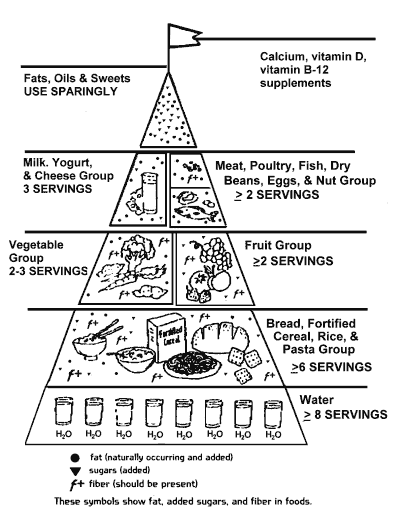|
|
Dr. MJ Bazos MD,
Patient Handout
A Modified Food Guide
Pyramid for People over 70 years
Three Tufts University researchers have tweaked
the US Dept. of Agriculture's Food Guide Pyramid to come up with a schematic
that they say more accurately represents the dietary needs of older consumers.
The Food Guide Pyramid was developed by the USDA
in 1992 as a visual representation of what they consider to be the components of
a healthful diet for everyone over age two. But seniors have some specific
nutrient needs not addressed in the "one size fits all" Food Guide Pyramid, say
the Tufts researchers, prompting them to make some modifications.
The base of their revised pyramid is narrowed,
signifying the reduced energy intake common among seniors. With an estimated
energy intake of 1200 to 1600 calories per day, elderly consumers have to make
every calorie count in order to get enough of essential nutrients. The "70+"
pyramid, therefore, outlines the "nutrient dense" choices in each food category,
emphasizing whole grain foods, varied colored fruits and vegetables, low-fat
dairy products, and lean meats, fish and poultry.
Icons throughout the grains, fruits, and
vegetable tiers of the pyramid highlight the importance of fiber in a healthful
diet. This is advice important for seniors but applicable to all adults, since
most Americans eat less than the 20 grams of daily fiber recommended by the
American Dietetic Association.
While grain foods anchor the USDA Food Guide
Pyramid, the "70+" pyramid is built on a base of water. Adequate hydration is a
chronic problem for many seniors. Decreased thirst sensation is common with
aging, and some medications affect a body's ability to regulate fluid balance.
Dehydration worsens symptoms of kidney dysfunction and constipation. To combat
this problem, this alternative pyramid advises seniors to drink at least 8
glasses of fluids a day.
The other key difference in the "70+" pyramid is
that is it topped with a flag icon that represents the possible need for dietary
supplements. Both calcium and vitamin D absorption decrease with age; this has
adverse effects on bone health and increases the risk of fractures. The ability
to absorb the vitamin B12 needed for normal nerve function also decreases with
age, making this another nutrient that needs to be "flagged" in the diet of
elderly consumers. While not all seniors may need dietary supplements, this is
an issue that all "70+" consumers should discuss with their health care
provider.
The Tufts researchers point out that these
dietary recommendations are aimed at healthy, mobile seniors with the resources
needed to prepare adequate meals. It it not designed to consider the special
dietary needs of those with significant health problems, nor does it address
socioeconomic factors, such as decreased income and mobility, that make it
harder for many seniors to meet nutrient needs. But all seniors, regardless of
circumstances, should still hear the pyramid's main messages: people over age
seventy have specific nutrient needs, and how well they meet those needs can
affect overall health status.
The "70+" pyramid is now just a suggestion; it
has not yet been adopted as an official USDA teaching tool. But the USDA and the
Dept. of Health and Human Services are in the process of revising the US Dietary
Guidelines on which the USDA Food Guide Pyramid is based, and the Tufts
researchers are hoping that their "70+" pyramid will generate some discussion on
how best to address the unique nutrient needs of seniors.
 |